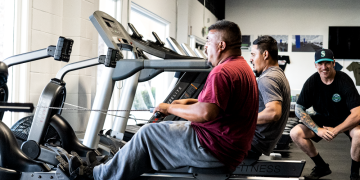Creating a fitness plan that works specifically for you can make a world of difference in achieving your goals. Whether you’re aiming to lose weight, build muscle, improve cardiovascular health, or simply stay active, a personalized fitness plan will help you stay consistent, motivated, and see results. Here’s a step-by-step guide on how to create a fitness plan that fits your needs and ensures the best possible outcomes.
1. Define Your Fitness Goals
Before you begin designing your workout plan, it’s important to clearly define what you want to achieve. Fitness goals should be specific, measurable, attainable, relevant, and time-bound (SMART). Some common goals include:
- Weight loss: Losing a certain number of pounds or body fat percentage.
- Muscle building: Increasing muscle mass in certain areas, like the arms, chest, or legs.
- Endurance: Improving cardiovascular endurance, such as being able to run a 5K.
- Flexibility and mobility: Increasing range of motion and reducing stiffness in the joints.
Make sure your goal is realistic and measurable. For example, “I want to lose 5kg in 3 months” is a specific and measurable goal that you can track, while “I want to lose weight” is too vague.
2. Assess Your Current Fitness Level
Understanding where you currently stand in terms of fitness will help you design a plan that’s achievable and safe. Assess your:
- Strength: Can you perform basic exercises like push-ups, squats, or planks? How many can you do without feeling fatigued?
- Cardiovascular fitness: How long can you jog or cycle at a moderate pace? Do you get winded after a few minutes of walking or running?
- Flexibility: Can you touch your toes without straining? How well can you perform stretching exercises?
- Mobility: Are there any joint issues, stiffness, or pain that restrict your movement?
Use these self-assessments to gauge where you need to improve, which will help determine the types of exercises you should incorporate into your plan.
3. Choose the Right Types of Exercises
Your fitness plan should include exercises that align with your goals and fitness level. Here are the different types of exercises to consider:
Strength Training
If your goal is to build muscle or increase strength, incorporate resistance training into your routine. This can include:
- Free weights: Dumbbells, kettlebells, and barbells.
- Bodyweight exercises: Push-ups, pull-ups, squats, lunges, and planks.
- Machines: Machines that target specific muscle groups like leg presses, chest presses, and lat pull-downs.
Strength training should be done at least 2-3 times a week, focusing on different muscle groups each time (e.g., legs on one day, arms and back on another).
Cardiovascular Exercise
If your goal is to improve endurance or lose weight, include some form of cardiovascular exercise. Options include:
- Running, cycling, or swimming: Great for improving cardiovascular health and burning calories.
- HIIT (High-Intensity Interval Training): Short bursts of intense exercise followed by rest periods. HIIT is efficient for fat loss and improving aerobic capacity.
- Walking: A low-impact option that still offers significant benefits, especially if you do it consistently.
Aim for at least 150 minutes of moderate-intensity cardio per week, or about 30 minutes a day, 5 days a week.
Flexibility and Mobility
Including flexibility exercises in your routine will improve your range of motion, prevent injury, and enhance muscle recovery. Consider incorporating:
- Yoga: Focuses on improving flexibility, balance, and mental relaxation.
- Dynamic stretching: For warming up before exercise (e.g., leg swings, arm circles).
- Static stretching: For cooling down after a workout (e.g., hamstring stretches, shoulder stretches).
Aim to stretch or do yoga at least 2-3 times a week.
4. Create a Balanced Weekly Routine
Once you’ve chosen the types of exercises you’ll incorporate into your plan, it’s time to structure them into a weekly routine. A well-rounded fitness plan should incorporate the following elements:
- Strength training (2-3 times a week): Focus on different muscle groups each time to avoid overtraining and promote recovery.
- Cardio (3-4 times a week): Include a mix of steady-state cardio (e.g., jogging, cycling) and high-intensity workouts (e.g., HIIT or interval training).
- Flexibility/mobility (2-3 times a week): Include daily stretching or yoga to keep your muscles lengthened and joints mobile.
Here’s an example of a weekly fitness schedule:
- Monday: Strength training (upper body)
- Tuesday: Cardio (moderate-intensity jog or bike ride)
- Wednesday: Strength training (lower body)
- Thursday: Cardio (HIIT or cycling)
- Friday: Full-body strength training
- Saturday: Flexibility/mobility (yoga or stretching)
- Sunday: Active rest (light walking or swimming)
5. Start Slow and Gradually Increase Intensity
If you’re new to working out or getting back into a routine, start slowly and gradually increase the intensity over time. Begin with lighter weights, lower-intensity cardio, and fewer repetitions. As your fitness level improves, you can increase the intensity, duration, and volume of your workouts.
For example:
- Start with 15-20 minute cardio sessions and work your way up to 30-40 minutes.
- Begin with bodyweight exercises and slowly add resistance once you’re comfortable.
- Start with light weights and increase the load as your strength improves.
This gradual progression ensures that you don’t overwhelm your body and helps prevent injury.

6. Prioritize Rest and Recovery
Rest and recovery are just as important as the workouts themselves. Overtraining can lead to fatigue, injury, and burnout, which will hinder progress. Make sure to:
- Get enough sleep: Aim for at least 7-8 hours of quality sleep per night for muscle recovery and overall well-being.
- Take rest days: Ensure you have at least 1-2 rest days per week to allow your muscles to recover and grow.
- Incorporate active recovery: Light activities like walking, yoga, or stretching can help promote recovery without putting additional strain on your body.
7. Track Your Progress
Keeping track of your progress is essential for staying motivated and seeing results. Use a fitness tracker, app, or journal to log your workouts, how much weight you’re lifting, the distance you’re running, or how many sets and reps you complete. Tracking progress will give you a sense of achievement and show you how far you’ve come, helping you stay motivated.
8. Listen to Your Body
It’s important to listen to your body and make adjustments if necessary. If you’re feeling fatigued, experiencing pain, or not recovering well, consider scaling back the intensity or taking extra rest days. Similarly, if you feel like you’ve hit a plateau, it might be time to change up your routine or challenge yourself with more intensity.
9. Stay Consistent and Be Patient
Consistency is the key to achieving long-term results. While it’s important to stay motivated, it’s equally important to be patient and allow your body the time it needs to adapt to your new fitness plan. Stick to your routine, make adjustments as needed, and celebrate small victories along the way.
Conclusion
Creating a fitness plan that aligns with your goals, fitness level, and preferences is the best way to achieve lasting results. By setting clear goals, choosing the right exercises, maintaining a balanced routine, and listening to your body, you can build a plan that works for you. With time, consistency, and a commitment to your plan, you’ll see improvements in strength, endurance, and overall health.

















































